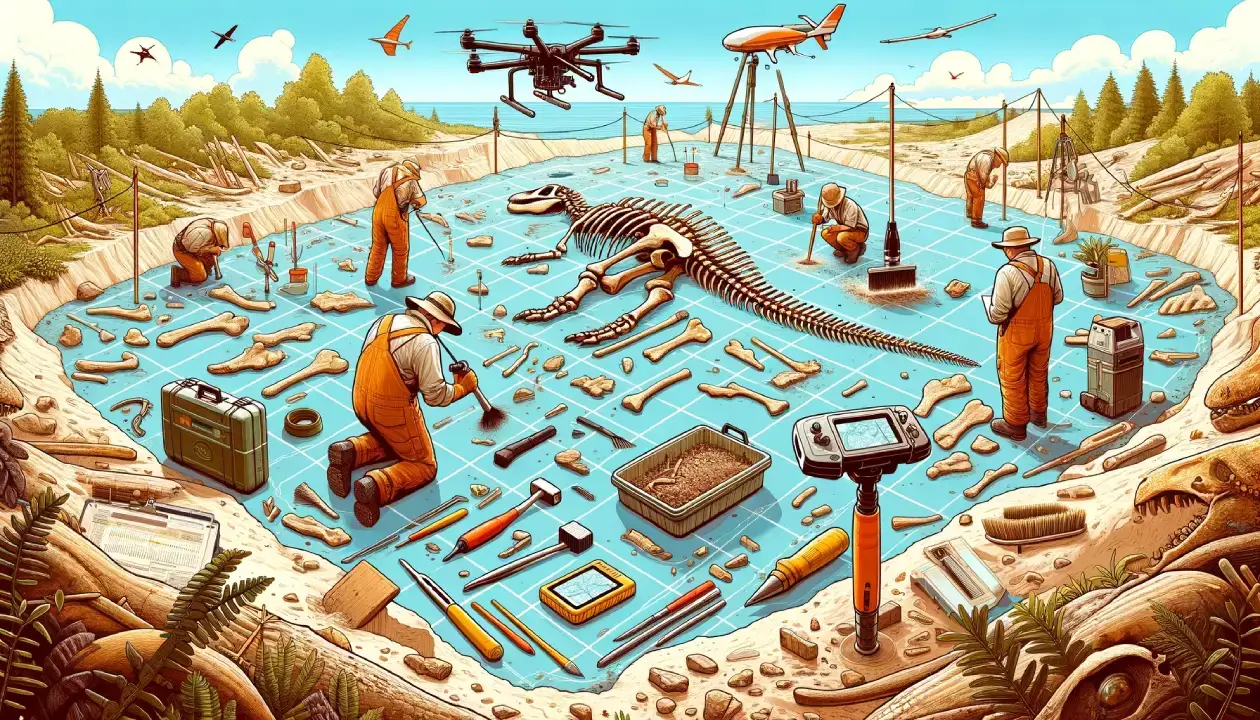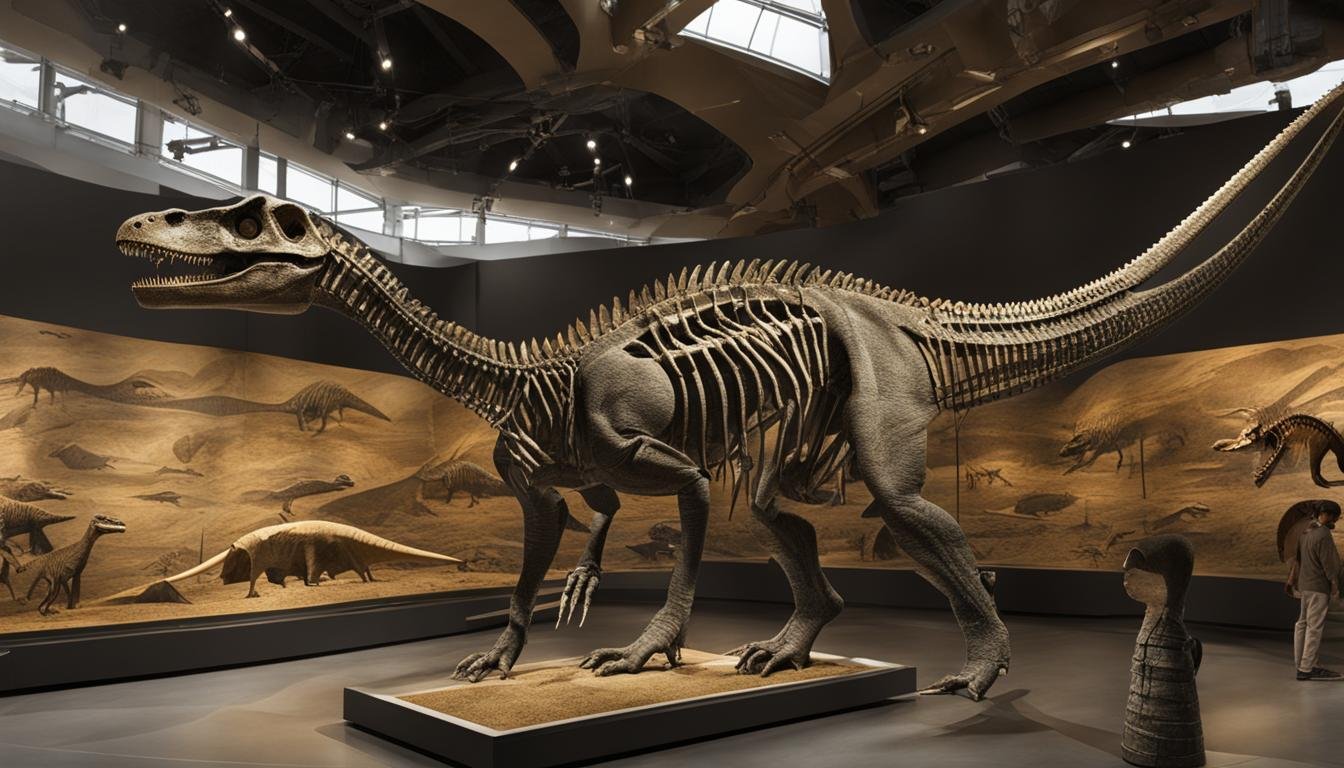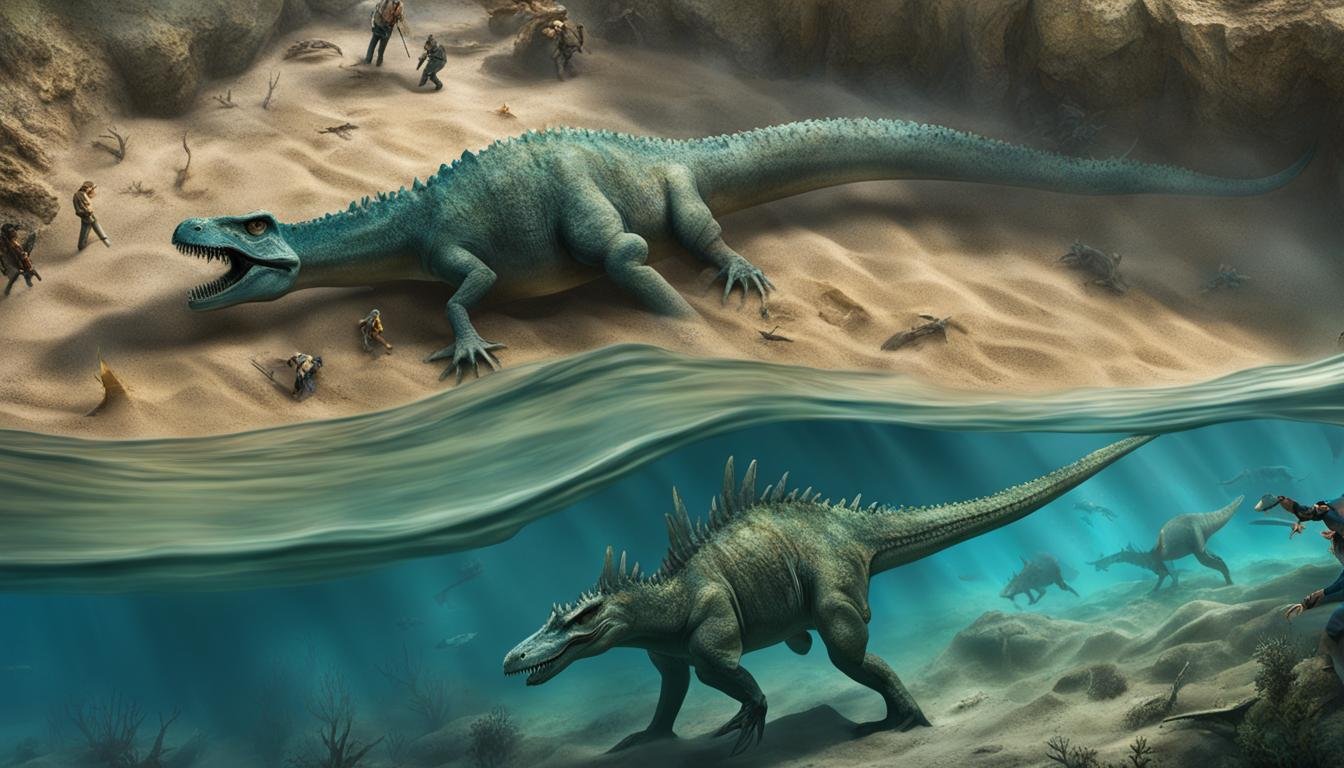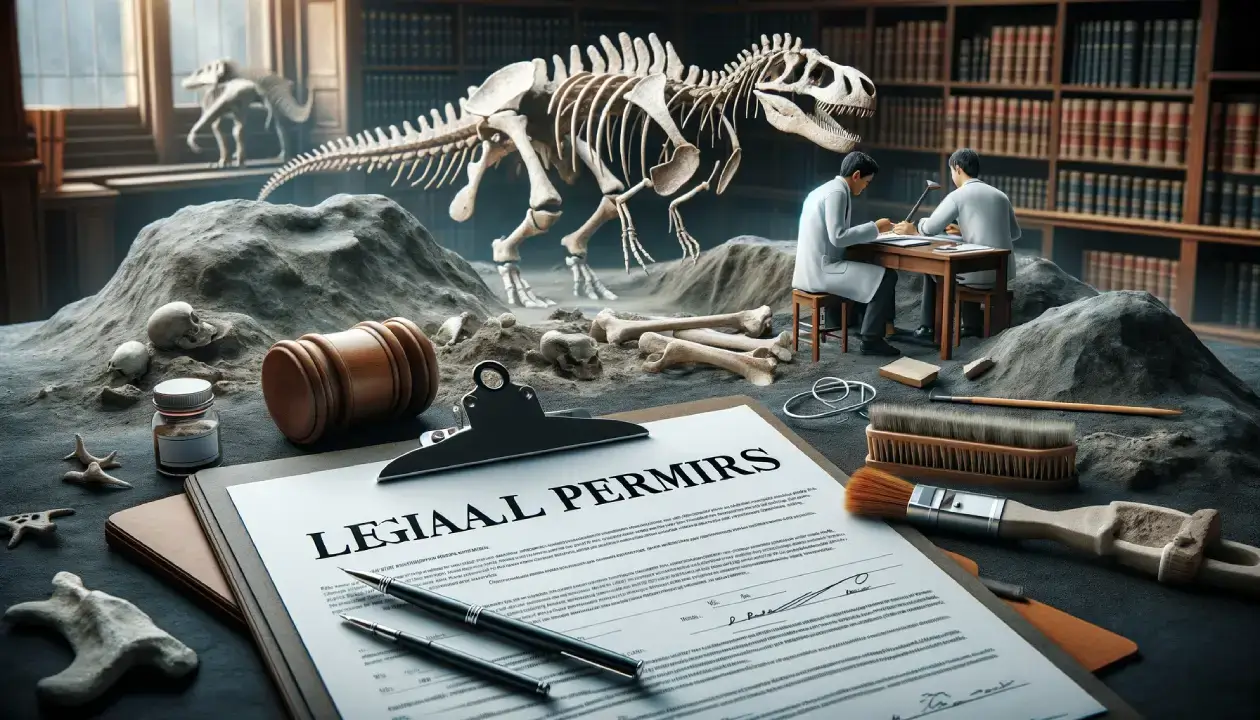Imagine a world where colossal creatures roamed, a time capsule buried beneath layers of earth, waiting to tell its story. This is the realm of fossil excavation, a field where history and science intertwine, unveiling the mysteries of prehistoric life. As we embark on this journey of discovery, we’ll explore the tools and techniques in fossil excavation that enable us to uncover these buried treasures. Each fossil unearthed is a puzzle piece in understanding the Earth’s past, a narrative millions of years in the making.
| Key Takeaways | Description |
|---|---|
| Hand Tools | Essential for precise work, including picks and hammers for breaking ground, trowels and brushes for uncovering fossils, and chisels and scalpels for detailed extraction. |
| Mechanical Tools | Utilized for efficiency and handling larger tasks, such as pneumatic hammers for matrix removal, air scribes for detail work, and jackhammers for excavating massive specimens. |
| Specialized Equipment | Includes advanced technology like GPS and drones for surveying excavation sites and mapping fossil locations with precision. |
| Excavation Techniques | Range from quarrying for large fossils, trenching for stratigraphic analysis, to sieving for small artifacts. |
| Fossil Preparation | Encompasses both mechanical and chemical methods to remove the surrounding matrix and conservation techniques to preserve fossils for future generations. |
| Safety Measures | Crucial for protecting archaeologists, with PPE, safety protocols, and environmental considerations to minimize impact on the site. |
| Ethical Practices | Important for respecting cultural heritage, encouraging collaborative efforts, and fostering public engagement in paleontology. |
| Future Prospects | Highlight technological advancements, citizen science, and international collaboration as key to unraveling the mysteries of past life on Earth. |
What is Fossil Excavation
Fossil excavation is more than just digging up old bones; it’s a gateway to the past. These remnants, preserved in stone, offer a glimpse into a world long gone. Through fossil excavation, we can reconstruct ancient ecosystems, understand evolutionary processes, and even predict future biological trends. It’s a crucial discipline that helps us piece together the history of life on Earth, from the tiniest microorganisms to the majestic dinosaurs.
Understanding the Challenges of Fossil Excavation
Unearthing fossils is no small feat. It requires patience, precision, and a deep understanding of geology and paleontology. Excavators face numerous challenges, from identifying potential fossil sites to delicately extracting the fossils without damage. Environmental factors, such as weathering and erosion, can complicate the process further. Each site presents its unique set of hurdles, demanding a blend of scientific knowledge and practical skills to successfully recover these ancient treasures.
Essential Tools for Fossil Excavation
Digging into the past requires not just enthusiasm but also the right tools. In fossil excavation, every tool has a specific purpose, ensuring the preservation of these age-old relics. Let’s delve into the archaeologist’s toolkit, exploring the array of equipment used in unearthing the secrets of the past.
| Category | Tool | Purpose |
|---|---|---|
| Hand Tools | Picks and Hammers | Breaking ground with precision; picks for chipping away rock, hammers for breaking tougher material. |
| Trowels and Brushes | Finer work such as moving small amounts of soil and cleaning fossils; brushes vary in softness for delicate dusting. | |
| Chisels and Scalpels | Delicately separating fossils from rock; crucial for meticulous extraction and preparation. | |
| Mechanical Tools | Pneumatic Hammers | Efficiently removing the matrix surrounding fossils; more effective than manual tools. |
| Air Scribes | Detailed work on fossils, providing precision without damaging the specimen. | |
| Jackhammers | Unearthing large fossils and specimens; used for bigger excavation tasks. | |
| Specialized Equipment | Surveying Equipment | Mapping out the excavation site; vital for planning and documentation. |
| GPS Technology | Pinpointing precise fossil locations; crucial for large-scale excavations. | |
| Drones | Aerial surveys of dig sites; providing a comprehensive view to assist in excavation planning. |
Hand Tools: The Archaeologist’s Toolkit
- Picks and Hammers: These are fundamental for breaking ground with precision. Picks, often small and pointed, are used for chipping away at rock, while hammers, ranging from light to heavy, are utilized for breaking tougher material.
- Trowels and Brushes: Essential for the finer work, trowels are used for moving smaller amounts of soil, and brushes, varying in softness, are crucial for dusting off and cleaning the unearthed fossils.
- Chisels and Scalpels: When it comes to delicately separating fossils from their rocky encasements, chisels and scalpels are indispensable. They allow for the meticulous extraction and preparation of fossils.
Mechanical Tools: Harnessing Power for Deeper Explorations
- Pneumatic Hammers: These tools revolutionize the removal of matrix (the rock surrounding the fossil) by providing a more efficient method than manual tools.
- Air Scribes: For detailed work on fossils, air scribes offer precision. They gently remove matrix without damaging the fossil.
- Jackhammers: When dealing with larger excavations, jackhammers are the go-to tool. They are used to unearth massive specimens that hand tools cannot handle.
Specialized Equipment: Navigating Diverse Environments
- Surveying Equipment: Before excavation begins, it’s vital to map out the site. Surveying equipment helps in planning and documenting the excavation process.
- GPS Technology: This modern tool aids in pinpointing precise fossil locations, crucial for large-scale excavations.
- Drones: For aerial surveys of extensive dig sites, drones offer a bird’s-eye view, helping paleontologists assess and plan their excavation strategy.
Each of these tools plays a pivotal role in the delicate process of fossil excavation. From the initial breaking of the ground to the intricate extraction of fossils, the right tool in the hands of a skilled paleontologist can reveal wonders from millions of years ago.
Techniques Employed in Fossil Excavation
In the world of paleontology, digging into the past is a meticulous art. Techniques in fossil excavation have been honed over years of trial, error, and triumph. Here’s a glimpse into the methods that set the stage for discovery and the initial steps to unveiling hidden fossils.
Initial Site Preparation: Setting the Stage for Discovery
Before the first tool ever touches the soil, a site must be prepared with care. This phase involves:
- Clearing vegetation: to ensure unobstructed access and minimize damage to the ecosystem.
- Mapping: creating a grid system over the site to record the precise location of each find.
- Photographing: taking detailed pictures from multiple angles to document the site’s original state.
These preparatory steps are crucial. They not only facilitate a systematic search but also ensure that all discoveries can be accurately recorded and studied later.
Prospecting and Surveying: Unveiling Hidden Fossils
Once the site is ready, the real hunt begins:
- Prospecting: This is the boots-on-the-ground phase where paleontologists scour the terrain, seeking signs of fossils on the surface.
- Surveying: Involves detailed measurements to map the site in three dimensions, often using sophisticated tools like GPS technology and drones for precision.
These initial steps are akin to opening chapters in a book — they set the context for the story that’s about to unfold from beneath the layers of time. Each measure, each sweep of the brush, brings us closer to connecting with creatures that haven’t walked the earth in millions of years.
Dive deeper into the intricacies of surveying techniques and their importance in paleontology by exploring our in-depth look at paleontological illustration and mapping.
Excavation Methods: Unearthing Buried Treasures
The quest to unearth prehistoric life from its stony grave is a blend of strength, precision, and science. Let’s dig into the excavation methods that allow us to reveal the long-buried treasures of our planet’s ancient inhabitants.
Quarrying: Unearthing Large Fossils
Quarrying is a large-scale excavation method, often reserved for sites where substantial fossil evidence is expected. This method involves:
- Removing large amounts of overburden: the soil and rock above the layer containing fossils.
- Systematic excavation: working in carefully planned stages to uncover large fossils that may extend over several meters.
Quarrying is especially suited for discovering massive dinosaur skeletons. It’s a method where power meets delicacy, as each strike of the tool holds the potential for monumental discovery.
Trenching: Exploring Stratigraphic Layers
Trenching provides a window into the vertical timeline of geology. Paleontologists dig narrow, deep trenches to:
- Examine sediment layers: understanding the sequence of layers helps determine the age of fossils.
- Sample for microfossils: tiny remnants of past life often reside within these layers, telling tales of ancient ecosystems.
This technique is akin to reading the Earth’s autobiography, with each stratum a chapter detailing an era long passed.
Sieving: Unveiling Small Fossils and Artifacts
Sieving might seem simple, but it’s a cornerstone in paleontological discoveries, especially when searching for small fossils and artifacts. It involves:
- Sifting through sediment: soil is carefully sieved to reveal small bones, teeth, and botanical remains.
- Water sieving: when sediments are suspended in water to separate the light organic remains from heavier inorganic matter.
Sieving is a testament to the fact that even the smallest pieces can offer immense insight into our planet’s prehistoric life.
In the dance of excavation, each step is measured, each movement calculated. The earth yields its secrets slowly, demanding respect and patience. To learn more about how these excavation methods have contributed to our understanding of dinosaurs, check out major dinosaur fossil discoveries.
Fossil Preparation: Preserving Ancient Treasures
After the thrill of discovery, the next critical phase in fossil excavation is preparation—a meticulous process that brings a fossil from the field to the lab and, eventually, to display or study. This stage is all about preserving the integrity and details of ancient treasures for generations to come.
Mechanical Preparation: Removing Matrix with Precision
Mechanical preparation is the first step in freeing fossils from their rocky prisons. This process typically involves:
- Using fine tools: like air scribes or pneumatic chisels to gently remove the surrounding matrix.
- Employing magnification: to see and preserve the minutest details during the removal process.
- Stabilizing the specimen: as the matrix is removed, fossils can become fragile and must be reinforced.
This phase can take many painstaking hours, as each fossil requires a tailor-made approach to ensure no detail is lost.
Chemical Preparation: Dissolving Matrix for Delicate Fossils
Sometimes, the matrix is too stubborn for mechanical tools, or the fossil too delicate. That’s when chemical preparation comes into play, using acids like acetic or formic acid to slowly dissolve the surrounding stone. This approach is delicate and requires:
- Neutralization processes: to stop the acid action at the right moment.
- Constant monitoring: to ensure that the fossil remains unharmed.
Chemical preparation is a dance with chemistry, requiring knowledge, patience, and a steady hand.
Conservation Techniques: Preserving Fossils for Future Generations
The ultimate goal of fossil preparation is conservation. This means:
- Applying consolidants: to strengthen the fossils.
- Controlling environmental factors: like humidity and temperature in storage and display areas.
- Recording all data: ensuring that all information about the fossil’s context is preserved alongside the physical specimen.
The conservation phase ensures that these ancient relics continue to educate and inspire awe long into the future. The dedication to preserving these ancient marvels allows us to have a tangible connection with the past.
Safety Precautions in Fossil Excavation
Safety is paramount in the meticulous process of fossil excavation. It’s not just about preserving history; it’s also about ensuring the well-being of those who uncover it. Here’s how safety is embedded in every layer of the excavation process.
Personal Protective Equipment: Ensuring Archaeologist Well-being
When on a dig, archaeologists gear up with personal protective equipment (PPE) to shield themselves from various hazards. PPE includes:
- Helmets: to protect from falling rocks or debris.
- Gloves: for handling sharp tools and rough materials.
- Steel-toe boots: to safeguard feet against heavy objects.
- Ear protection: when using loud machinery.
- Dust masks or respirators: especially when working in dusty conditions or with potentially toxic chemicals.
Site Safety Protocols: Minimizing Risks and Hazards
Beyond personal gear, there are protocols in place to maintain a secure site:
- Regular safety briefings: keeping everyone informed about potential risks.
- Clear signage: marking hazardous zones and ensuring that safety equipment is used.
- Emergency procedures: including first aid training and ready access to medical kits.
These protocols are not just guidelines but lifelines, especially when working in remote locations.
Environmental Considerations: Preserving the Excavation Site and Surrounding Environment
Fossil excavation is conducted with the utmost respect for the environment. This involves:
- Controlling site access: to minimize disturbance to the ecosystem.
- Responsible waste management: ensuring that nothing harmful is left behind.
- Restoration plans: to return the site to its natural state post-excavation.
By taking these precautions, archaeologists not only protect themselves but also the integrity of the sites they excavate, ensuring that the history they uncover doesn’t come at the expense of the present environment. Safety in fossil excavation is as complex and layered as the dig sites themselves. It’s a blend of preparedness, awareness, and respect—for the fossils, the process, and the people involved.
Ethics in Fossil Excavation
Ethical considerations in fossil excavation are as important as the scientific methods employed. They guide paleontologists to not only uncover the past with integrity but also to honor the story each fossil tells.
Responsible Excavation Practices: Respecting Cultural Heritage
Fossils are not just scientific specimens; they’re part of the cultural tapestry of the regions where they’re found. Responsible practices include:
- Securing proper permits: ensuring all excavations are legal and sanctioned.
- Engaging with local communities: to understand and respect the area’s cultural significance.
- Leaving some fossils in situ: for future scientists and for the public to appreciate in their natural context.
These practices help maintain a balance between discovery and respect for the heritage that belongs to all humankind.
Collaborative Efforts: Sharing Knowledge and Expertise
Paleontology is a field built on collaboration. By sharing knowledge and expertise, the scientific community can:
- Improve excavation techniques: through shared experiences and research.
- Enhance understanding of findings: by bringing together diverse perspectives.
- Build international relationships: fostering unity and cooperation across borders.
Collaboration ensures that the field grows collectively and that the insights gained from fossil excavation have a far-reaching impact.
Public Engagement: Fostering Interest in Paleontology
Involving the public is key to keeping the field of paleontology vibrant and relevant. Efforts include:
- Educational programs: to inspire the next generation of scientists.
- Museum exhibits: that allow people to experience discoveries firsthand.
- Media outreach: sharing findings through various channels to educate and engage a broader audience.
Public engagement turns fossil excavation from a niche science into a shared human story, sparking curiosity and wonder in people of all ages. Ethics in fossil excavation not only ensure the integrity of the practice but also secure its future by weaving the thrill of discovery with the fabric of education and cultural appreciation.
The Future of Fossil Excavation
The future of fossil excavation shines with the promise of innovation and collaboration. As we stand on the threshold of new discoveries, let’s explore the advancements that are shaping the destiny of paleontology.
Technological Advancements: Enhancing Excavation Efficiency and Precision
The evolution of technology plays a pivotal role in transforming fossil excavation:
- Imaging Technology: Non-invasive methods, like CT scans, allow us to peek inside fossils without damaging them.
- 3D Printing: Replicas created from 3D printing are revolutionizing the way we handle and study fossilized remains.
- Machine Learning: Algorithms are being developed to sift through soil samples and identify potential fossil fragments more quickly than the human eye.
These advancements not only speed up the excavation process but also enhance the precision with which we can study these ancient relics.
Citizen Science Initiatives: Expanding the Scope of Discovery
Paleontology is not just for paleontologists anymore. Citizen science initiatives have opened the field to amateur fossil enthusiasts, who contribute to:
- Data collection: Public participation in reporting and locating fossils has expanded the reach of research.
- Crowdsourced analysis: Online platforms allow anyone with an internet connection to participate in data sorting and analysis.
- Educational outreach: These initiatives educate the public, fostering a community passionate about prehistoric life.
By involving citizen scientists, paleontology taps into a wealth of enthusiasm and diversity, driving the science forward with renewed vigor.
International Collaboration: Unraveling the Mysteries of the Past
As the puzzle of Earth’s prehistoric life is vast and complex, international collaboration is essential. Scientists across the globe are:
- Sharing findings: Through databases and joint publications, contributing to a centralized body of knowledge.
- Working together on digs: Multinational teams bring a wealth of experience and resources to the field.
- Educating globally: Exchange programs and workshops help spread techniques and knowledge far and wide.
This spirit of cooperation is essential in the quest to piece together our planet’s ancient history.
Conclusion: Unveiling the Tapestry of Life
The significance of fossils in understanding Earth’s history cannot be overstated. Each fossil is a thread in the vast tapestry of life, revealing the intricacies of evolution and biodiversity. Fossil excavation has propelled scientific advancements, providing insights into climate change, extinction events, and even the origins of life itself. The enduring fascination with prehistoric life continues to captivate our imagination and fuels our quest for knowledge.
The story of life is written in the fossils we find, and as we refine our methods and collaborate across continents, we turn more pages of Earth’s grand narrative. To explore how we’re preparing for these future advancements, take a look at our insights on the future of dinosaur paleontology.









